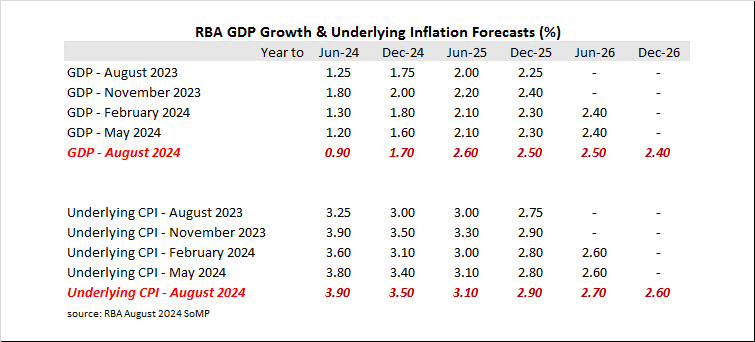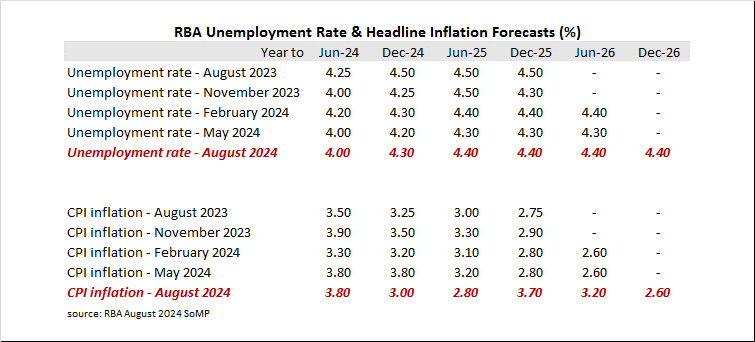Summary: RBA trims GDP forecasts out to June 2024, forecasts for later periods raised; underlying inflation forecasts raised by modest amounts; jobless rate expected to rise slightly, stabilise in mid-4s in 2025; headline inflation forecasts to June 2025 cut, later periods raised; ACGB yields generally rebound; rate-cut expectations soften; ANZ: more hawkish than June and May.
The Statement on Monetary Policy (SoMP) is released each quarter and it is closely watched for updates to the RBA’s own forecasts.
In May’s SoMP, the opening sentence of the “Global Outlook” section stated the overall outlook was little changed from that of February. “The overall outlook for growth in Australia’s major trading partners in 2024 is little changed. The stronger forecast growth in 2024 in the United States and China…is offset by downward revisions to growth in New Zealand, Japan and some middle-income economies in east Asia.“
As far as Australia was concerned at the time, “Economic growth is expected to remain subdued over most of 2024, with the outlook a little weaker than three months ago, as earlier interest rate increases continue to weigh on demand.”
August’s “Global Outlook” is largely In line with May’s view, albeit with a slight tweak. “The 2024 forecast is a little higher than was forecast three months ago; the 2025 forecast remains unchanged.” The RBA expects higher-than-expected growth in “high-income east Asia”, or in other words, South Korea and Japan, to “offset slightly weaker growth forecasts for the G7 economies and China…”
From a domestic view, this latest SoMP stated has changed slightly but not materially. “The outlook for GDP growth in 2024 is similar to three months ago. Imports growth was much stronger than expected in the March quarter and this has offset a stronger near-term outlook for public demand and household consumption growth relative to three months ago.”
Even so, the RBA’s GDP growth forecasts for the year to June 2024 have been trimmed by 0.30 percentage points while the growth forecast for years to December 2024, June 2025, December 2025 and June 2026 have been raised by 0.10 percentage points, 0.50 percentage points, 0.20 percentage points and 0.10 percentage points respectively.
“Relative to three months ago, GDP growth has been revised up in the year to mid-2025, with an upgrade to public demand growth partially offset by stronger growth in imports and weaker dwelling investment growth.”
The RBA’s underlying inflation forecasts have been generally raised by modest amounts for all forecast periods with the exception of June 2025. However, the RBA still expects inflation to move below the top of its target range by December 2025. However, it is not expected to reach the middle of the bans until December 2026, six months later than previously expected.
“Relative to the May Statement, the forecast for underlying inflation has been revised higher from mid-2025 to reflect the assessment that there will be a little more excess demand in the economy than previously estimated.”
The RBA’s view of the unemployment rate typically follows from its forecasts of GDP growth. The unemployment rate has been mostly fluctuating between 3.50% and 3.90% during 2023 and early 2024 and the RBA now expects it to rise modestly to 4.30% by the end of 2024 and then stabilise around 4.40% in 2025 and 2026.
“The unemployment rate is forecast to increase further over coming quarters, reflecting the continued easing in leading indicators of labour demand such as job vacancies and hiring intentions.”
Headline inflation forecasts have been lowered by 0.80 percentage points for the year to December 2024 and by 0.40 percentage points for the year to June 2025. However, forecasts for periods further out have been raised.
“New and extended electricity rebates and increases to rent assistance are expected to subtract around 0.6 percentage points from year-ended headline inflation in the September quarter of 2024. However, the legislated unwinding of some policies in 2025 will push headline inflation to back above the target range before converging towards underlying inflation once these temporary factors have passed.”
The statement came out at the same time as the latest RBA policy decision and Commonwealth Government bond yields generally rebounded in a reversal of the previous day’s slump. By the close of business, the 3-year ACGB yield had jumped 29bps to 3.60%, the 10-year yield had gained 16bps to 4.03% while the 20-year yield finished 5bps lower at 4.41%.
Expectations regarding rate cuts in the next twelve months softened, although a February 2025 rate cut is still fully priced in. In the cash futures market, contracts implied an average of 4.315% in September, 4.29% in October and 4.195% in November. February 2025 contracts implied 4.04% while August 2025 implied 3.665%, 67bps less than the current cash rate.
“At the risk of reading too much into the RBA’s words, if anything we’d view it as more hawkish than June and May,” said ANZ Head of Australian Economics Adam Boyton.



